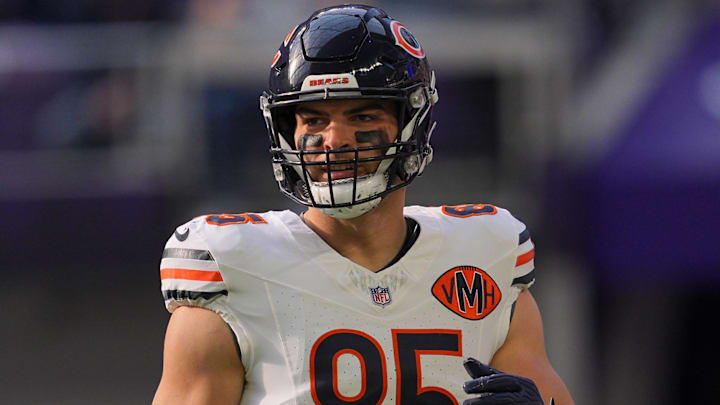With multiple other directions they could've gone with the first draft pick of the Ben Johnson era, the Chicago Bears sent an undeniable message by using the 10th overall pick in last April's draft on tight end Colston Loveland.
For some people, Loveland was not even the best tight end in the 2025 draft class. For the Bears, incumbent No. 1 tight end Cole Kmet instantly landed in well-founded trade speculation after Loveland was selected. That said, the idea of trading Kmet ignored Johnson's tendency to have two tight ends on the field when he was the Detroit Lions' offensive coordinator.
So Kmet would have a place in the Bears' offense as Loveland got going in his rookie season, and likely beyond. Johnson's plans to get Loveland more involved in the offense heading into Week 3 were derailed by a hip injury early in that game, and he did not play in the next game.
Kmet failed to assert himself as the Bears' No. 1 tight end in the game Loveland missed, against the Las Vegas Raiders. That stood to set Loveland up for a big role when the team came out of their Week 5 bye.
In Week 7 against the New Orleans Saints, Loveland played more snaps than Kmet for the first time. Then Kmet missed Week 8 and the takeover fully bloomed, highlighted by Loveland's huge breakthrough performance against the Cincinnati Bengals in Week 9.
Bears need to come to unavoidable realization about Cole Kmet
Loveland has played more than 61 percent of the offensive snaps in each of the Bears' six games since the bye week. Over that span, he has put the idea that the Bears should've drafted fellow rookie tight end Tyler Warren all the way to bed.
since Week 7 (when Colston Loveland started playing 65%+ of the snaps)
— Jeremy (@JeromeyR0me) November 25, 2025
Yards per reception
Loveland: 14.1
Tyler Warren: 11.2
Yards per route run
Loveland: 2.66
Warren: 2.13
PFF grade
Loveland: 72.1
Warren: 67.7
Touchdowns
Loveland: 3
Warren: 1
Over the last six games he has played, Kmet has had more than one catch and two targets once. By comparison, Loveland has not had fewer than four targets or three catches in any of his last six games.
It might be easy to lament how Kmet is impacting Loveland's production based on sheer snaps, but it's not happening based on actual roles in the Bears' passing game.
As hinted previously, the Bears use 12 personnel (one running back, two tight ends) at the ninth-highest rate in the league entering Week 13 (30.6 percent, according to Sumer Sports). Over the last three games, Loveland has played 140 offensive snaps to Kmet's 145.
In the parlance of the tight ends Johnson had in Detroit his last couple seasons there, Loveland has become Sam LaPorta and Kmet has become a better version (top-20 Pro Football Focus grades as a run and pass blocker so far this season) of Brock Wright.
Kmet's is among the 10 highest-paid tight ends in the league right now, which automatically comes with an expectation he'll be a bit more than a better version of a fringe roster-worthy backup tight end. But that's what his role with the Bears is now, for better or worse, and it's been mostly out of his control as Loveland has asserted himself.
After this season, Kmet has two years left on his four-year, $50 million contract. Trading him in the offseason (before June 1) would clear $8.4 million of his $11.6 million cap hit for 2026 off the books, with the rest left behind in dead money.
If Kmet is going to be the No. 2 tight end with hardly any role in the passing game, the Bears can go a far cheaper route for that role in 2026. An offseason trade could also give him the chance to be the TE1 elsewhere.
Read more: Ozzy Trapilo gets well-deserved praise for how he stepped up vs. Steelers
Trading a player you've so heavily invested in contractually is never easy. But last offseason's speculation about Kmet is set to become a reality for the Bears this offseason, and it will likely be the best thing for both sides.
